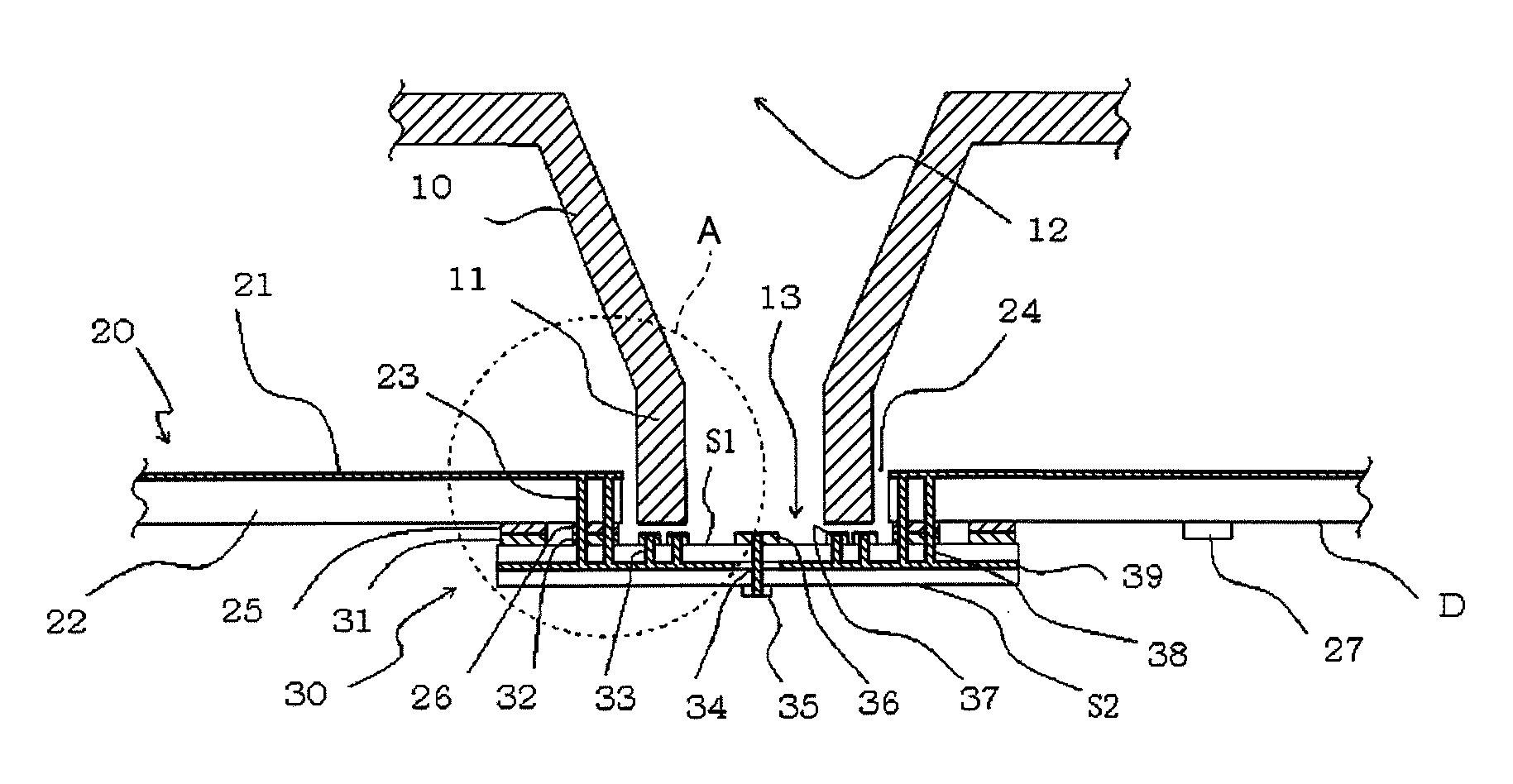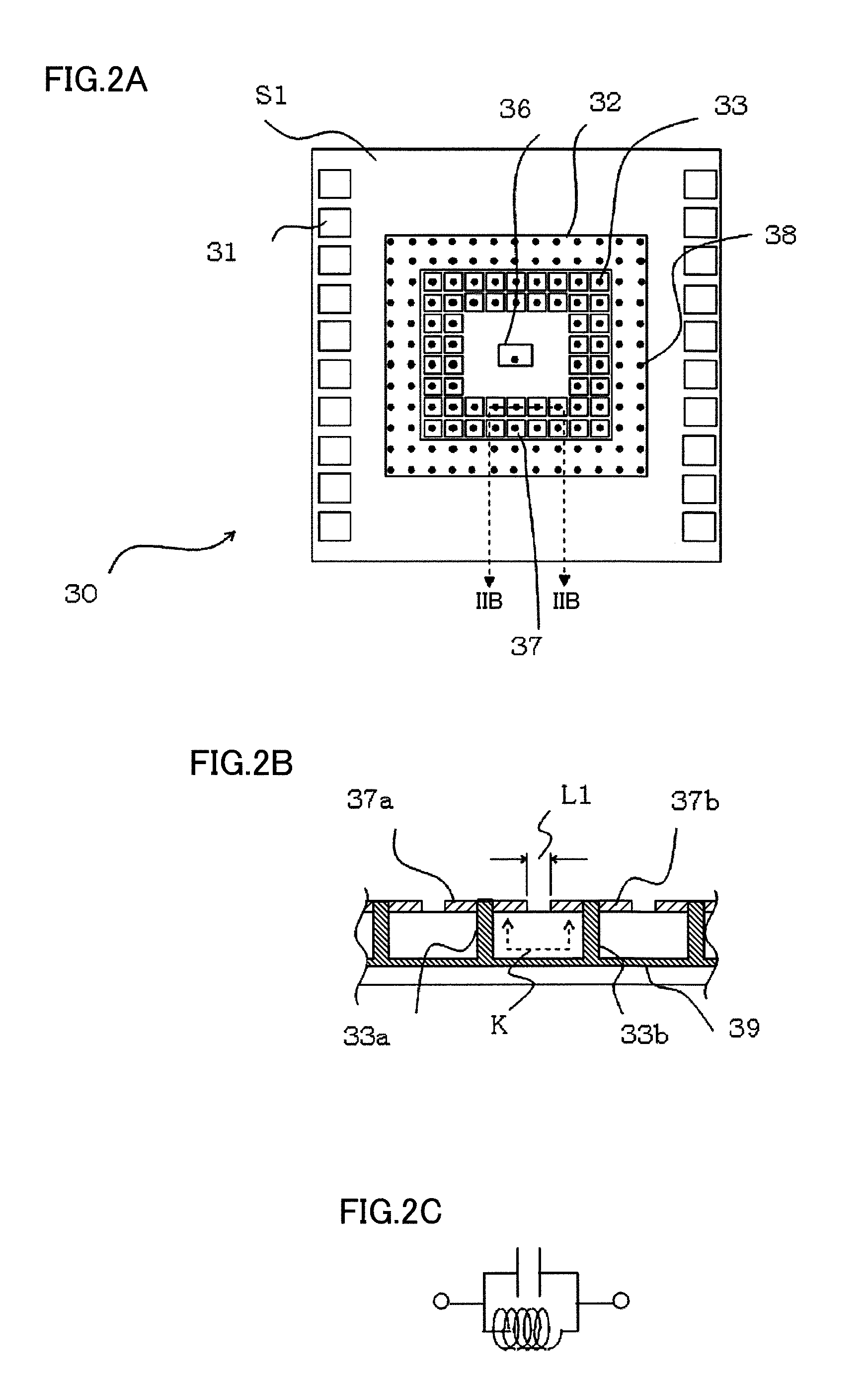Antenna element-waveguide converter and radio communication device using the same
a radio communication device and element waveguide technology, applied in waveguide horns, antennas, electrical devices, etc., can solve the problems of insufficient contact, direct impact of antenna gain drop, fragile and light, etc., to avoid stress, improve reliability, and avoid the effect of complicating the manufacturing process
- Summary
- Abstract
- Description
- Claims
- Application Information
AI Technical Summary
Benefits of technology
Problems solved by technology
Method used
Image
Examples
first embodiment
[0034]A first embodiment of an antenna element-waveguide converter of the present invention will be described with reference to FIGS. 1A to 4.
[0035]First, a configuration example of an antenna element-waveguide converter 1 in the first embodiment will be described with reference to FIGS. 1A and 1B. As shown in FIG. 1B, antenna element-waveguide converter 1 includes antenna substrate 30, a waveguide 11 arranged with an opening 13 opposed to a surface of this antenna substrate 30, and horn antenna 10 coupled to waveguide 11. Antenna substrate 30 is mounted on a mounting board 20 in application to a radio communication device. It should be noted that antenna substrate 30, opening 13, and mounting board 20 correspond to a first substrate, a first opening, and a second substrate of the present invention, respectively.
[0036]An example of the overall configuration of antenna substrate 30 will now be described with reference to FIG. 1B. Antenna substrate 30 is implemented by a multilayer su...
second embodiment
[0049]A second embodiment of the present invention will now be described with reference to FIGS. 5A and 5B. Radio communication device 2 is obtained by incorporating antenna element-waveguide converter 1 described in the first embodiment into a housing formed by a chassis 42 and a frame 44, and attaching a signal terminal 43 for connection to an external apparatus (not shown). It should be noted that parts identical to those in the first embodiment are denoted by identical reference characters.
[0050]Chassis 42 and frame 44 are made of resin, and surface mounted component 27, such as a capacitor and a resistor, is mounted in advance on mounting board 20, in addition to antenna substrate 30. Mounting board 20 is attached to chassis 42 at corner portions 45 in the four corners with screws 41. Horn antenna 10 is attached to chassis 42 with screws 40. In more detail, horn antenna 10 and chassis 42 both have L-shaped ends, and are attached to each other with screws 40 after these L-shaped...
third embodiment
[0053]A third embodiment of the present invention will now be described with reference to FIGS. 6A and 6B. FIGS. 6A and 6B show an external appearance of a radio communication device 3. FIG. 6A is a plan view as viewed from horn antenna 10, and FIG. 6B is a cross sectional view taken along the line VIB-VIB in FIG. 6A. Radio communication device 3 is obtained by incorporating antenna element-waveguide converter 1 of the first embodiment shown in FIGS. 1A and 1B into an inner space enclosed by chassis 42 and frame 44, and attaching signal terminal 43 for connection to an external apparatus (not shown), to the outside of a connecting portion of chassis 42 and frame 44. It should be noted that elements in the third embodiment identical to those in the second embodiment are denoted by identical reference characters. The third embodiment differs from the second embodiment in that chassis 42, horn antenna 10, and waveguide 11 are integrally molded of metal, and in that frame 44 is also mad...
PUM
 Login to View More
Login to View More Abstract
Description
Claims
Application Information
 Login to View More
Login to View More - R&D
- Intellectual Property
- Life Sciences
- Materials
- Tech Scout
- Unparalleled Data Quality
- Higher Quality Content
- 60% Fewer Hallucinations
Browse by: Latest US Patents, China's latest patents, Technical Efficacy Thesaurus, Application Domain, Technology Topic, Popular Technical Reports.
© 2025 PatSnap. All rights reserved.Legal|Privacy policy|Modern Slavery Act Transparency Statement|Sitemap|About US| Contact US: help@patsnap.com



